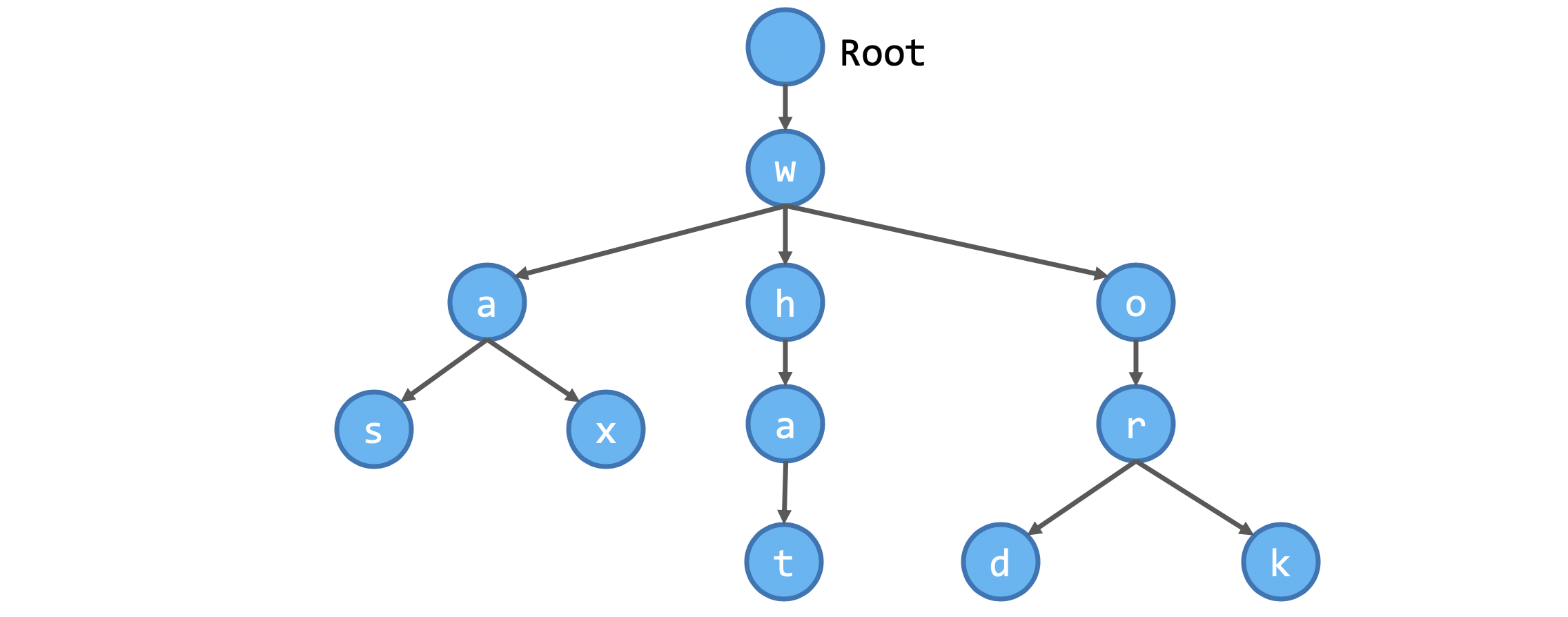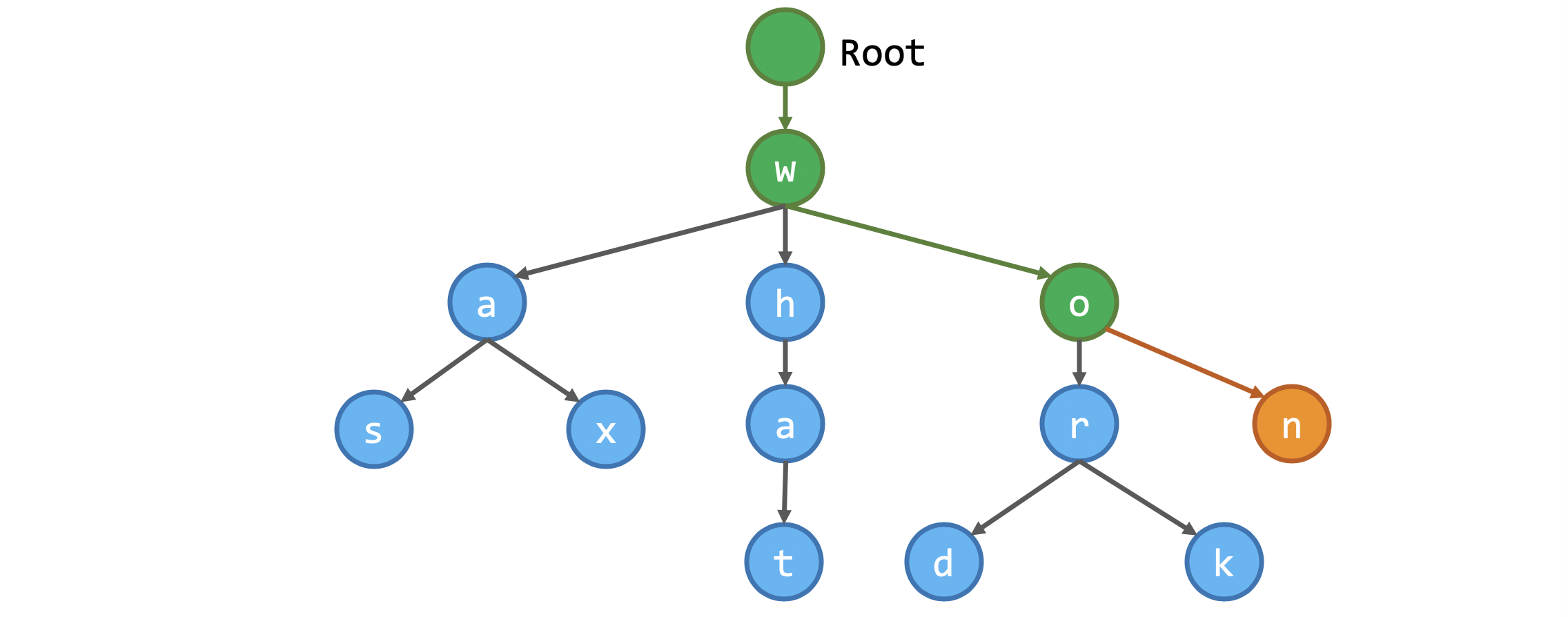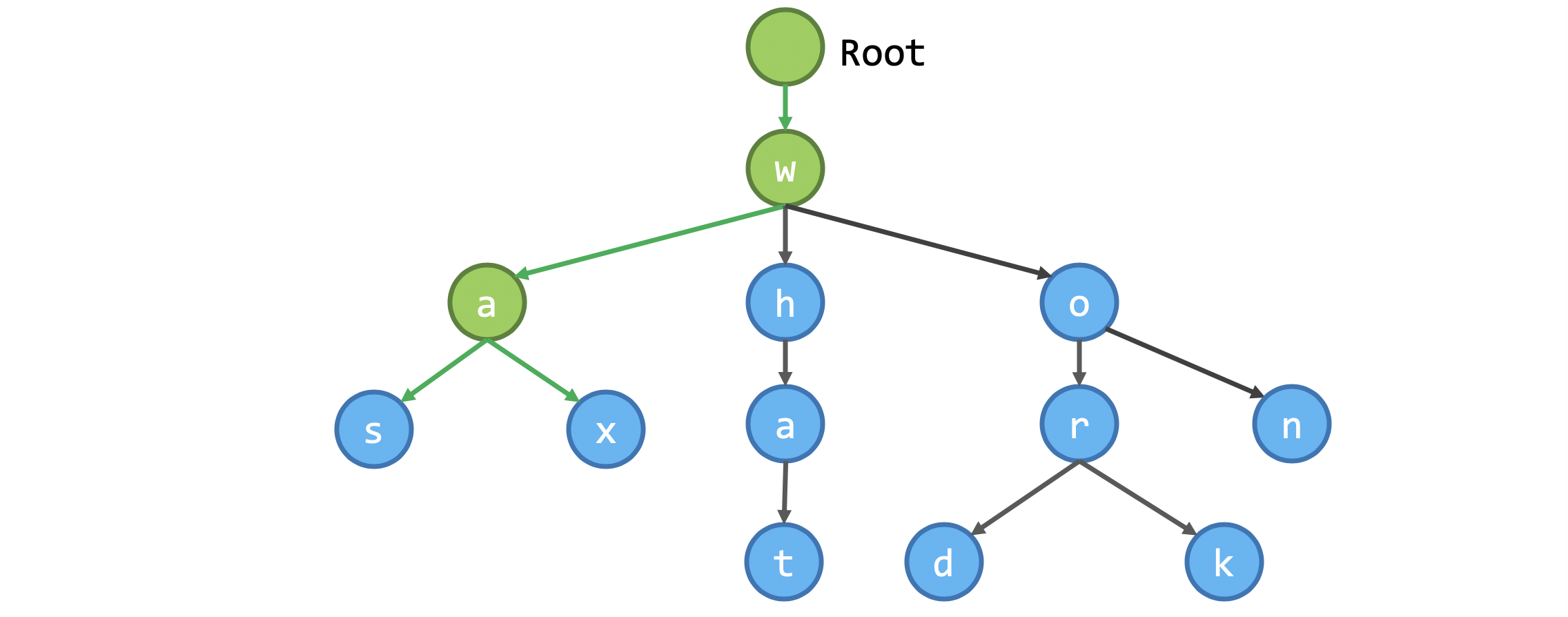What is a Trie?
Trie is a very useful data structure. It is commonly used to represent a dictionary for looking up words in a vocabulary.
For example, consider the task of implementing a search bar with auto-completion or query suggestion. When the user enters a query, the search bar will automatically suggests common queries starting with the characters input by the user.
To implement such a function, we need several things at the backend. The first, obviously, is a list of common queries. Or it can be a list of proper English words for the purpose of auto-completion). Secondly, we will need to have an algorithm to quickly look up words starting with the characters input by the user, and this is where we need to use the trie data structure.
The follow example illustrates why a special data structure is necessary to look up words quickly given a prefix:
- The user inputs the characters
en - In our dictionary, we have the following words starting with
en:english,entertainment - Commonly used data structures such as
listanddictionaryin Python do not allow quick look up of elements stored inside. For example, to see if there is any word having the prefixenin a Python dictionary, we cannot avoid going through each of the keys, resulting inO(n)time, wherenis the number of entries in the dictionary
Trie is a tree-like data structure made up of nodes. Nodes can be used to store data. Each node may have none, one or more children. When used to store a vocabulary, each node is used to store a character, and consequently each “branch” of the trie represents a unique word. The following figure shows a trie with five words (was, wax, what, word, work) stored in it.

How does a Trie Work?
There are two major operations that can be performed on a trie, namely:
- Inserting a word into the trie
- Searching for words using a prefix
Both operations involves traversing the trie by starting from the root node. We take a look at each of these operations in more detail.
Inserting Words into the Trie
In order to insert a new word into the trie, we need to first check whether any prefix of the word is already in the trie. Therefore, we will start traverse the trie from the root node, and follow the algorithm below:
- Set the current node to be the root node
- Set the current character as the first character of the input word
- Check if the current character is a child of the current node
- If yes, set the current node to be this child node, set the current character to the next character in the input word, and perform this step again
- If no, it means from this character onwards, we will need to create new nodes and insert them into the trie
Below is an illustration of what will happen when we want to add the word won into the trie above.

Following the steps in the algorithm mentioned above, we will arrive at the node o under w, at which point we discover that n is not a child of o, and therefore we create a new node for the character n, and insert it under o.
Searching in the Trie
A common application scenario of the trie data structure is to search for words with a certain prefix, just like the auto-complete or query suggestion function in a search bar.
When given a prefix, we can traverse the trie to check if any word in the trie starts with that prefix. If the prefix is found in the trie, we can then use depth-first traversal to retrieve all the words with that prefix.
For example, given the trie illustrated above, which contains the words was, wax, what, word, work and won, let’s see what will happen if we want to search for words with the prefix wa:

- Starting from the root node, we are able to find the node
wanda - From the node
a, we can go on to traverse the trie to retrieve all words starting with the prefixwa - When we arrive at the node
s, we check whether it is the end of a word (yes), and the wordwaswas output - Similarity, when we arrive at the node
x, the wordwaxis output
Implementing Trie in Python
To implement a trie, we can first create a TrieNode class, which can be used to represent a node in the trie. Below is how this class can be implemented.
class TrieNode:
"""A node in the trie structure"""
def __init__(self, char):
# the character stored in this node
self.char = char
# whether this can be the end of a word
self.is_end = False
# a counter indicating how many times a word is inserted
# (if this node's is_end is True)
self.counter = 0
# a dictionary of child nodes
# keys are characters, values are nodes
self.children = {}
In this implementation, we want to store also the number of times a word has been inserted into the trie. This allows us to support additional features, such as ranking the words by their popularity.
Given the TrieNode class, we can go on to implement the Trie class as follows.
class Trie(object):
"""The trie object"""
def __init__(self):
"""
The trie has at least the root node.
The root node does not store any character
"""
self.root = TrieNode("")
def insert(self, word):
"""Insert a word into the trie"""
node = self.root
# Loop through each character in the word
# Check if there is no child containing the character, create a new child for the current node
for char in word:
if char in node.children:
node = node.children[char]
else:
# If a character is not found,
# create a new node in the trie
new_node = TrieNode(char)
node.children[char] = new_node
node = new_node
# Mark the end of a word
node.is_end = True
# Increment the counter to indicate that we see this word once more
node.counter += 1
def dfs(self, node, prefix):
"""Depth-first traversal of the trie
Args:
- node: the node to start with
- prefix: the current prefix, for tracing a
word while traversing the trie
"""
if node.is_end:
self.output.append((prefix + node.char, node.counter))
for child in node.children.values():
self.dfs(child, prefix + node.char)
def query(self, x):
"""Given an input (a prefix), retrieve all words stored in
the trie with that prefix, sort the words by the number of
times they have been inserted
"""
# Use a variable within the class to keep all possible outputs
# As there can be more than one word with such prefix
self.output = []
node = self.root
# Check if the prefix is in the trie
for char in x:
if char in node.children:
node = node.children[char]
else:
# cannot found the prefix, return empty list
return []
# Traverse the trie to get all candidates
self.dfs(node, x[:-1])
# Sort the results in reverse order and return
return sorted(self.output, key=lambda x: x[1], reverse=True)
Below is an example of how this Trie class can be used:
>>> t = Trie()
>>> t.insert("was")
>>> t.insert("word")
>>> t.insert("war")
>>> t.insert("what")
>>> t.insert("where")
>>> t.query("wh")
[('what', 1), ('where', 1)]
References
- Trie, Wikipedia
- Tries, Brilliant.org
- Trie (Prefix Tree) - Visualizing the operations on a trie
